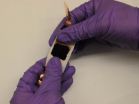(Press-News.org) Tampa, FL (Dec. 14, 2012)— A new study focusing on how people with dementia become lost while driving, how missing drivers are found, and the role of public notification systems like Silver Alert in these discoveries suggests techniques that may help recover drivers with dementia and prevent potentially harmful incidents.
The study was led by principal investigator Meredeth A. Rowe, RN, PhD, FGSA, FAAN, professor and endowed chair at the University of South Florida College of Nursing. The findings were published online last month in the Journal of the American Geriatrics Society: Missing Drivers with Dementia: Antecedents and Recovery.
Based on the study results, the research team reported several recommendations to help guide local policies and training for Silver Alert-type programs that broadcast information about missing seniors with Alzheimer's disease, dementia or other cognitive deficits, including:
Rapid, direct notification of law enforcement agencies as well as equipping officers a mechanism for quickly assessing the cognitive status of drivers is critical. Law enforcement officers are more likely than citizens or family members to discover missing drivers with dementia.
More detailed information about a missing individual, not just a description of the car being driven, may better assist law enforcement officers and citizens in rescuing lost drivers who have left their vehicles to wander on foot.
State and federal agencies planning a Silver Alert program need to develop policies and procedures that recognize the distinct differences between those missing while driving and those lost while walking.
Retirement from driving is the only preventive option when individuals can no longer safely operate a motor vehicle because dementia interferes with their ability to retain and use new information.
"With the baby-boomer generation getting older, the number of the people living with Alzheimer's disease is on the rise," Dr. Rowe said. "Most Americans depend on driving their own car to meet their transportation needs, even for the most basic needs such as food. It will be critical to identify other means of transportation for people with dementia (PWD) to facilitate driving retirement. This strategy will be the most effective intervention to reduce and prevent incidents of missing PWDs. Strategies commonly recommended, such a hiding the car keys, are potentially protective only in a small number of cases."
According to Alzheimer's Association, 5.4 million Americans live with Alzheimer's disease, including 800,000 who live alone. One in eight older Americans lives with the memory-robbing disease, including 450,000 Floridians age 65 or older. These statistics highlight the need to find more effective ways to search for missing drivers with dementia and reduce missing incidents.
Dr. Rowe and her colleagues analyzed 156 records from the Florida Silver Alert program for October 2008 through May 2010. These alerts are issued on digital highway signs and news broadcasts in Florida to assist law enforcement officials and the general public in identifying and safely returning cognitively impaired drivers.
The researchers found that most missing drivers were men, ages 58 to 94, who were cared for by a spouse. Most got lost on routine, caregiver-sanctioned trips to usual locations. Only 15 percent were found while driving, with most discovered in or near a parked car — and law enforcement officers recovered the large majority of drivers with dementia.
In addition, only 40 percent were found in the county where they were reported missing, and 10 percent were found in a different state. Another 15 percent were found in dangerous situations such as stopped on railroad tracks. There was a 5 percent mortality rate in the study population, with those living alone more likely to be found dead than alive.
"While some PWDs may continue to drive safely, it is imperative that we identify individuals who will get lost, determine predictors of modifiable outcomes, and establish policies that will improve location of those individuals who get lost," said study co-author James E. Galvin, MD, MPH, professor of neurology and psychiatry New York University Langone Medical Center.
A comprehensive Silver Alert program that includes law enforcement and community education as well as rapid alerts is critical to finding missing drivers, the researchers conclude.
Their findings led to recommendations for an additional study on how notifications be more effectively delivered to facilitate increased recoveries from "Good Samaritan" citizens.
The researchers emphasize that getting cognitively impaired people to retire from driving may be the single most effective measure for prevent missing incidents that may lead to injury or death.
"Important aspects of successful driving retirement include a partnership between the healthcare practitioner and caregiver to support the decision for driving retirement, the identification of
local and state programs… and assistance in finding alternative forms of transportation in the community," they report.
###
USF Health's mission is to envision and implement the future of health. It is the partnership of the USF Health Morsani College of Medicine, the College of Nursing, the College of PublicHealth, the College of Pharmacy, the School of Biomedical Sciences and the School of Physical Therapy and Rehabilitation Sciences; and the USF Physician's Group. The University of South Florida is a global research university ranked 50th in the nation by the National Science Foundation for both federal and total research expenditures among all U.S. universities.
NYU Langone Medical Center, a world-class, patient-centered, integrated, academic medical center, is one on the nation's premier centers for excellence in clinical care, biomedical research and medical education. Located in the heart of Manhattan, NYU Langone is composed of four hospitals – Tisch Hospital, its flagship acute care facility; the Hospital for Joint Diseases, one of only five hospitals in the nation dedicated to orthopaedics and rheumatology; Hassenfeld Pediatric Center, a comprehensive pediatric hospital supporting a full array of children's health services; and the Rusk Institute of Rehabilitation Medicine, the world's first university-affiliated facility devoted entirely to rehabilitation
END
Parents often wonder how much of the world their young children really understand. Though typically developing children are not able to speak or point to objects on command until they are between eighteen months and two years old, they do provide clues that they understand language as early as the age of one. These clues provide a point of measurement for psychologists interested in language comprehension of toddlers and young children with autism, as demonstrated in a new video-article published in JoVE (Journal of Visualized Experiments).
In the assessment, psychologists ...
(Santa Barbara, Calif.) –– While some theoretical physicists make predictions about astrophysics and the behavior of stars and galaxies, others work in the realm of the very small, which includes quantum physics. Such is the case at UC Santa Barbara, where theoretical physicists at the Kavli Institute for Theoretical Physics (KITP) cover the range of questions in physics.
Recently, theoretical physicists at KITP have made important strides in studying a concept in quantum physics called quantum entanglement, in which electron spins are entangled with each other. Using ...
At crucial points in the metabolism of all organisms, a protein with the unwieldy name of Translation Elongation Factor P (EF-P, for short) takes center stage. What it actually does during protein synthesis has only now been elucidated – by researchers at Ludwig-Maximilians-Universität in Munich.
The research group led by Kirsten Jung, Professor of Microbiology at LMU, actually focused on how bacteria cope with stress, for example how the receptor meolecule CadC monitors the acidity in the environment and alerts the cell to take countermeasures to protect itself. However, ...
This press release is available in German.
The mass ratio of protons and electrons is deemed to be a universal constant. And rightly so, as the latest radio-astronomy observations of a distant galaxy have shown. Scientists at the VU University of Amsterdam and the Max Planck Institute for Radio Astronomy in Bonn used the 100-metre radio telescope in Effelsberg to measure absorption lines of the methanol molecule at a number of characteristic frequencies. The researchers analysed the spectrum of the simplest of all the alcohols in a very distant galaxy. The result: to ...
The pelvic exam, a standard part of a woman's gynecologic checkup, frequently is performed for reasons that are medically unjustified, according to the authors of a UCSF study that may lay the groundwork for future changes to medical practice.
The research shows that many physicians mistakenly believe the exam is important in screening for ovarian cancer. The study, which surveyed obstetricians and gynecologists around the country, also shows that doctors continue to perform the exam in part because women have come to expect it.
The article is currently published online ...
Antibodies are key to the recognition and neutralisation of bacteria by our immune system. The most common antibodies have the shape of a Y, and the two prongs fasten to molecules that belong to the bacteria. The cells in the immune system recognise the shaft and can then attack the bacteria.
Since the 1960s, it has been known that certain bacteria have developed the ability to turn these antibodies around, which makes it more difficult for the immune system to identify them. These include streptococcus bacteria, sometimes referred to as 'killer bacteria', that cause ...
Memo to casino operators: just because you build it doesn't mean they will come.
A new study out of the University of Iowa examined how casino growth in the state has influenced gambling by residents. The survey suggests that fewer Iowans gambled overall and also that fewer people have become addicted to gambling despite a recent spurt in gaming facilities. Casino gambling was introduced in Iowa in 1991. There are currently 21 casinos in Iowa, all but three licensed by the state. (The others are owned and operated by Native American tribes.)
The findings could affect ...
ANN ARBOR, Mich. — The University of Michigan Health System doesn't claim to be perfect. But its response to medical errors, near-misses, unexpected clinical problems and unintended outcomes is a model for the nation that other hospitals can and should copy, according to a new paper in a prestigious health care journal.
The "Michigan Model" for handling these situations, and preventing them from happening again, has not only helped patients and medical staff alike – it has also helped UMHS go against the grain of the costly, combative "deny and defend" medical malpractice ...
Electronic devices become smaller, lighter, faster and more powerful with each passing year. Currently, however, electronics such as cell phones, tablets, laptops, etc., are rigid. But what if they could be made bendable or stretchy?
According to the University of Delaware's Bingqing Wei, stretchable electronics are the future of mobile electronics, leading giants such as IBM, Sony and Nokia to incorporate the technology into their products.
Beyond traditional electronics, potential stretchable applications include biomedical, wearable, portable and sensory devices, ...
(SALT LAKE CITY)—Buprenorphine is a safe and effective drug for treating opioid addiction. But as the prescribed use of buprenorphine has dramatically increased in recent years, accidental exposure of children to the drug has risen sharply, placing them at risk for serious injury and in extremely rare cases even death, according to researchers at the Utah Poison Control Center (UPCC), U School of Medicine's Department of Family and Preventive Health, and the Utah Department of Health (UDOH).
In a study published Thursday, Dec. 13, 2012, by the U.S. Centers for Disease ...





